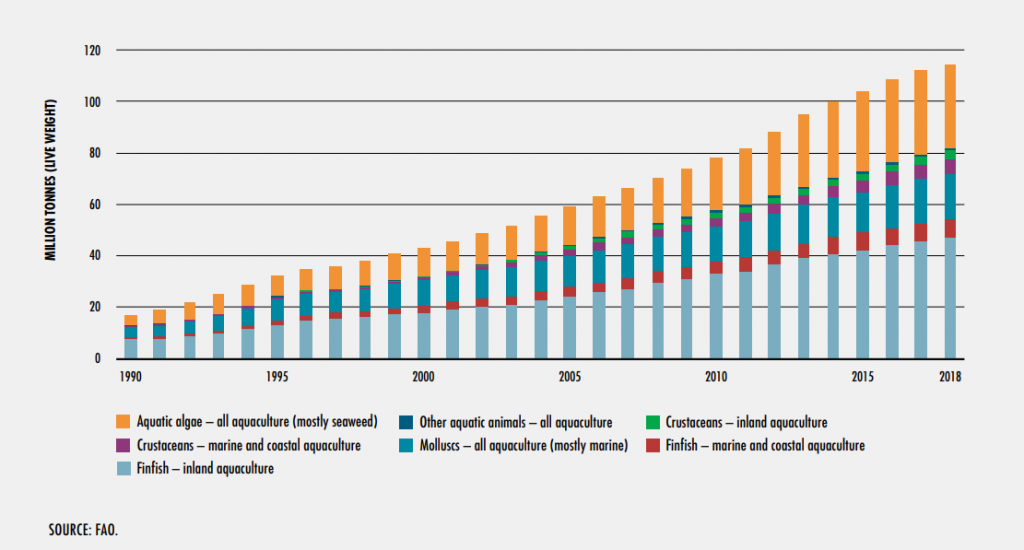Aquaculture Status
Global aquaculture production is estimated to have reached 114.5 million metric tons in 2018, worth a total value of $263.6 billion. ref This consisted of:
- 1 million tons of aquatic animals
- 4 million tons of aquatic algae
- 26 thousand tons of ornamental shells and pearls
Finfish dominated the aquatic animals, at a total of 54.3 million tons of which 47 million were from inland, and 7.3 million were from marine and coastal areas. ref Mollusks, mainly bivalves, made up the next largest group of aquatic animals, estimated at 7.3 million tons worth about $35.4 billion. Global seaweed aquaculture represented 97.1% by volume of the total 32.4 million tons of wild-collected and cultivated aquatic algae combined in 2018. Global seaweed production from finfish aquaculture is expected to continue to grow and outpace wild fisheries by 2030.

World aquaculture production of aquatic animals and algae, 1990-2018. Source: FAO 2020
Despite the diversity of species grown globally, aquaculture production is dominated by a relatively small number of staple species: ref
- Finfish: Only 20 species make up the majority (approximately 84%) of the total farmed finfish. Most of the top fish species farmed are freshwater - primarily carp, catfish, and tilapia. Milkfish (Chanos chanos) are globally the most significantly farmed tropical marine finfish species, with production numbers in 2018 reaching 1.32 million tons and comprising 2.4% of the farmed fish production. From 2010 to 2018, milkfish production numbers increased 39% for an average annual increase of approximately 10% each year. ref Other tropical/subtropical finfish species that are farmed include, but are not limited to: barramundi, grouper, snapper, pompano (pomfret), croaker, red drum, Japanese sea bass, cobia, and with some newer interest in rabbitfish.
- Seaweeds: Japanese kelp (Laminaria japonica) and Eucheuma seaweeds (Eucheuma spp.) are the most farmed seaweeds by weight globally. Eucheuma is often used as raw material for carrageenan extraction and Japanese kelp is used in food and as a source of iodine. ref
- Shellfish: Cupped oysters (Crassostrea), Japanese carpet shell (Ruditapes phillipinarum), and scallops together make up over 64% of mollusks farmed in world aquaculture. ref
- Other animals: Chinese softshell turtle (35%) and Japanese sea cucumber (19%) account for the majority of all other animals farmed in world aquaculture. ref
